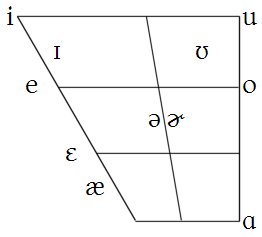What's wrong with "imitated pronunciation" and how to read the IPA
I'm sure you've heard the saying "one picture is worth a thousand words" ...

|

|
| The Gaelic Vowel Space | The English vowel space |
Never mind what all the symbols mean right now, just play "spot the difference" and bear in mind we're ignoring something called diphthongs for now.
Now, you might think, ok, but surely the consonants will be much more similar. In the words of Dirty Harry, are you feeling lucky?
| Faidhle:consainghaidhlig.jpg | Faidhle:consainbheurla.jpg |
| Gaelic consonants | English consonants |
See what I'm driving at? At this stage of learning, even without understanding what all the symbols mean, it's is obvious that Gaelic and English have vastly different sound inventories. In actual fact, you've chosen to learn a language with one of the most complex system of sonorants (L N and R) anywhere in the world. Daunting? Perhaps, but be proud of it. And it IS learnable, trust me.
But back to Imitated Pronunciation. Sometimes it works, for example, if you wanted to represent the sounds of Basque with Spanish syllables/letters. That's possible because there are a large number of sounds common to both languages. But you simply can't do that with English and Gaelic; the two are just too different. English doesn't have clear vowels, Gaelic does. English doesn't have a long/short vowel distinction, Gaelic does. English has one L, N and R, Gaelic has three distinct sounds for each. English has two dental fricatives, neither of which is much help in Gaelic. English has a [w] which isn't any help because Gaelic doesn't have it. It's a loooong list.
So using English sounds/syllables to create a system of Imitated Pronunciation is not going to work - <lap-ee> and <cheen> are as far removed from the Gaelic words leabaidh and tighinn as <sing> and <oftalmolodschist> are from <thing> and <opthalmologist>.
So why the IPA? Haven't I enough to worry about?
Actually, the IPA is there to help you make your life easier. Anyway, you don't have to learn all of it, just the bits you need for Gaelic. It's as reliable tool as you will find in writing down the sounds of any language because it was developed by linguists to do just that. True, it's not 100% perfect, but what is?
So what do you need to know?
The key principle in the IPA (International Phonetic Alphabet) is that one specific symbol stands for only one specific sound. This specific sound can then be described in more detail by using a set of squiggles, correctly termed diacritics. Diacritics can sit over, under, or behind a symbol and they always have a smaller size than a full IPA symbol. That's it, for the general principle. So let's look at the symbols and squiggles you'll need, for Gaelic. And by the way, you don't have to learn the names of the symbols. The IPA is just a tool, to help you, not a purpose in itself:
| Symbol | Name | Meaning & Usage | English Example | Gaelic Example |
|---|---|---|---|---|
| ː | vowel length | placed after a vowel symbol it shows that this vowel is long | [griːn] green | [kaːr] càr |
| ̃ | tilde | placed over a vowel to show it is nasal in quality | [ʃɛ̃v] sèimh | |
| ˠ | velarisation | placed behind a consonant, it shows that this consonant is velarised, i.e. your velum is lowered. | [ãũn̪ˠ] ann | |
| ̪ | dental sign | placed under a consonant it shows that this sound is made with your tongue touching your teeth. | [ãũn̪ˠ] ann | |
| ' | apostrophe | placed before a syllable it shows that this syllables carries primary stress | [pər'mɪt] permit | [ə'max] a-mach |
| ʰ | superscript h | placed either before or after a consonant it shows that slight aspiration either precedes or follows a consonant. After word initial stops like p, t, k etc ʰ is generally not written because these sounds are automatically aspirated both in Gaelic and in English when they appear at the beginning of a word. So you will only see them at the beginning of a word in the two examples on the right. | [pʰər'mɪt] permit | [kʰuʰpə] cupa |
| ʲ | superscript j | placed after a consonant it shows that this consonant is palatalised, i.e. your tongue is touching your palate during articulation | [d̊ʲiən] dèan | |
| . | fullstop | placed between two vowels it shows that these vowels do not form a diphthong and belong to the same syllable, but rather that they are two separate vowels belonging to two different syllables | [siː.iːgl] sea-eagle | [fi.əx] fitheach |
| ̊ | hollow circle | placed over or under a consonant this shows that the consonant is devoiced, i.e. has no voicing anymore. See Guide to Voicing | [g̊ə] gu |
That's the quick guide to most of the sguiggles (diacritics) you'll see on this site - we're not even using all of them because we're using a slightly simplified version these days.
| Beagan gràmair | ||||||||||||
| ᚛ Pronunciation - Phonetics - Phonology - Morphology - Tense - Syntax - Corpus - Registers - Dialects - History - Terms and abbreviations ᚜ | ||||||||||||